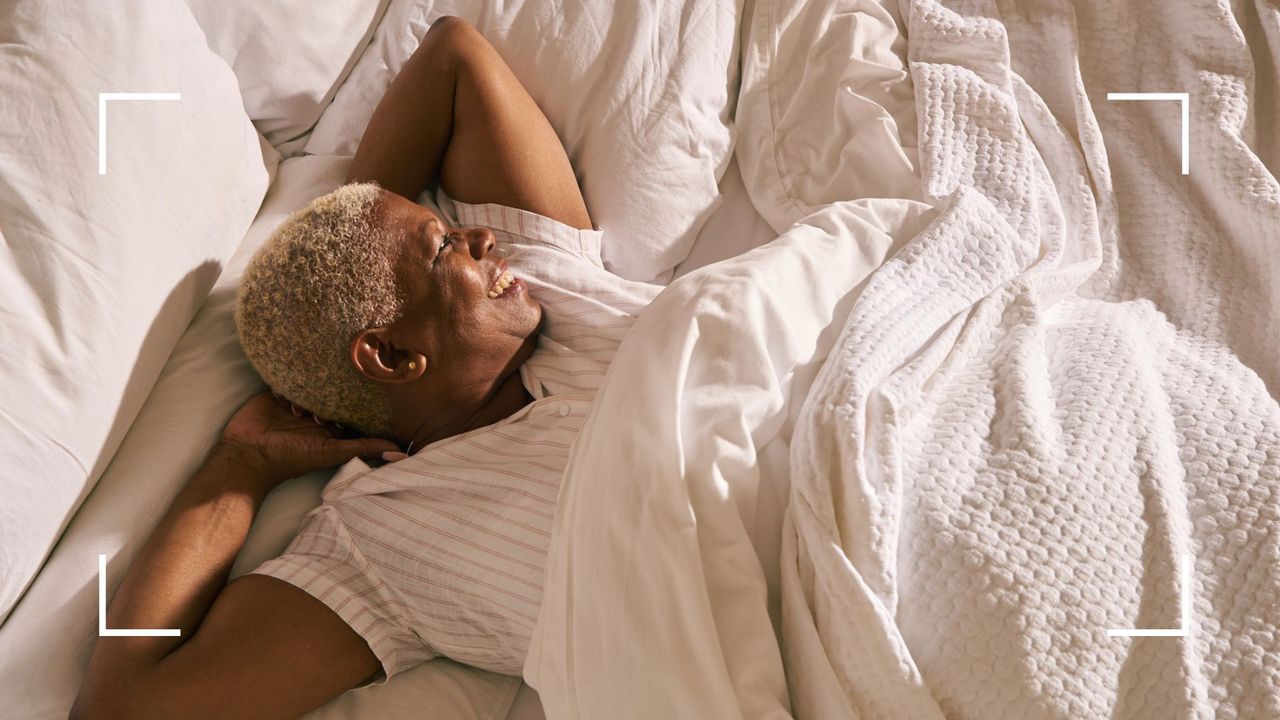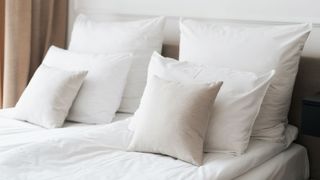Should I sleep with a pillow between my legs? Experts reveal the benefits it can have for your health
Sleeping with a pillow between your legs can alleviate back pain and help you sleep better. Here, an osteopath and sleep specialist explain how


Can sleeping with a pillow between your legs help you sleep better? If you find yourself tossing and turning every night, waking up at all hours with a sore back, neck, or hips then this could be something for you to try.
When it comes to our sleep, it's not only the bedtime routine that matters. Of course, switching off your phone and settling down for a relaxing night's sleep is important but how you sleep and specifically the position of your body may play more of a role in our sleep quality than we think.
To dig deeper into the role that our body positioning plays in learning how to sleep better and to explore the benefits of putting a pillow between your legs, we've spoken to a certified osteopath and a sleep scientist.
Should I sleep with a pillow between my legs?
Sure, it might look a little strange to the person you may be sharing a bed with but sleeping with a pillow between your knees can really help to improve your sleep hygiene, helping you have better quality sleep for longer. From helping with back and neck pain to potentially improving your posture overall, keeping an extra pillow on hand to tuck between your legs as you fall asleep can have numerous benefits for side, back, and front sleepers alike.
1. Sleeping with a pillow between your legs will help with lower back pain
The main reason people sleep with a pillow between their legs is to help with lower back pain. "It keeps your pelvis in alignment and prevents your back from twisting, keeping it in a neutral position and helping to relieve the tissues and reduce paint," says osteopath Phyllis Woodfine. "Having your knees on top of one another will also help to prevent your hips and spine from moving into a non-neutral position and prevent twisting, keeping the hips in alignment."
According to The Sleep Foundation, over 51% of us sleep on our sides - but what about the other 49%? Chances are you won't be able to reap the benefits of putting a pillow between your legs when sleeping if you don't find your side a comfortable position to get into for sleep in the first place.
For those who prefer sleeping on their back or on their front, sleep and body clock scientist Kat Lederle has some advice: "It's not just the pillow between your legs [that can be helpful," she says. "Also [putting one] under your knees if you are sleeping on your back or under your stomach or pelvis if you sleep on your front can help to prevent or minimise back pain."
Sign up for the woman&home newsletter
Sign up to our free daily email for the latest royal and entertainment news, interesting opinion, expert advice on styling and beauty trends, and no-nonsense guides to the health and wellness questions you want answered.
She does point out, however, that sleeping on your front "is probably one of the worst positions for the alignment of your spine" so even the best pillows in the world may not be able to help you. If this is your preferred one and you're having issues, consider changing it up if you can and speaking to a specialist.

2. It may help you sleep better
There's almost nothing worse for you than continued poor sleep. Research from many institutions, including the University of Pittsburgh and Emory University School of Medicine, shows that the quality and duration of our sleep impacts everything to do with our health - from our energy levels to how we store fat and even our risk of stress-induced conditions like burnout from work. Anything we can do to sleep better is going to be beneficial for our overall health.
As Lederle says, "If you have a poor night’s sleep you will feel tired the next day. And often it is not just tiredness, you may also feel grumpy or low, struggle to concentrate and can’t find the motivation to socialise. In addition, there might be strain or pain in the body which won’t help. All in all, it is not a nice day, not a day you want to repeat. And so the pressure to sleep well the following night increases. Now, when we put pressure on ourselves to sleep we often find it even harder to sleep well. What follows is another 'rubbish” day." Finding a good sleeping position, with or without sleep aids, is going to be at least a step in the right direction.
And Woodfine agrees that a pillow between the legs could help some people. "Sleeping with a pillow between your knees may help you to have a better night's sleep as you are less likely to turn over or move into a less advantageous position, such as lying on your front or with the pelvis and/or hips twisted," says the osteopath.
3. Can help improve circulation
If you have problems with circulation in your legs, chances are that you struggle during the day with symptoms like weak and fatigued muscles, pins and needles, cold toes, and potentially some numbness.
Woodfine says that sleeping with a pillow between your legs can help with this. "This position can also generally promote better circulation to the lower limbs and reduce tension and muscle cramps, as well as reduce any stress on the knees," she says.
4. May help prevent snoring
There are some sleeping positions that make conditions like snoring more likely. For example, it's been proven (in research by Sint Lucas Andreas Hospital in Amsterdam) that those who sleep on their back are more likely to snore than those who sleep in other positions.
So, Lederle says, that "anything that makes sleeping on your side more comfortable will be beneficial" to help combat this.
5. May help with menopause symptoms
While there's little to no direct evidence that sleeping with a pillow between your legs can help with alleviating the symptoms of perimenopause or menopause, difficulty sleeping is one of the biggest concerns and that's where the technique comes in.
"Any position that is comfortable and helps you would be beneficial," says Woodfine. "In menopause, it's good to have limited tension in the muscles and improve circulation of the blood to the lower limbs, which this position would aid in sleep."
But she warns, in this case, the material of your pillow matters. "Having good ventilation and non-synthetic bedding would help with any hot flushes or discomfort so that you are feeling cool and comfortable whilst sleeping," she says. If you're looking to upgrade, take a look at our guides on the best pillows for side sleepers and the best cooling mattresses.

Does sleeping with a pillow between your legs help neck pain?
Yes, much like how sleeping in this position can help with lower back pain, a pillow put between your legs in the right way as you fall asleep can help with potential neck pain. Naturally, it's best to consult a certified medical expert such as an osteopath or chiropractor if you're having issues in this area, but there is reason to believe it will help.
"Your body posture matters during the night because if your neck, shoulders, back and hips become misaligned this can lead to muscle strain and pain," says Lederle. "And that pain can then have a negative impact on the quality of your sleep."
Is it good to sleep with a pillow between your legs during pregnancy?
Yes, sleeping with a pillow between your legs is advice often given to those during pregnancy and you can even buy specialist pillows designed for this purpose.
"Pregnant women are advised to sleep on their left side with a pillow between their legs, and one behind their back and perhaps their belly as well. Again, it depends on the individual person but this will reduce pain and discomfort, and so improve sleep. There is also some research suggesting that sleeping on the side minimised the risk of stillbirth," says Lederle, pointing to the University of Auckland report published in The Lancet.
How to sleep with a pillow between your legs
- Lie on your side with your knees slightly bent towards your chest
- Put a pillow (medium to firm) between the knees so your hips are in a neutral position
- If necessary, the top leg can be slightly in front on another softer pillow but you will probably need to use two pillows to maintain the neutral position
- Your spine should be aligned straight and not curved

Grace Walsh is woman&home's Health Channel Editor, working across the areas of fitness, nutrition, sleep, mental health, relationships, and sex. She is also a qualified fitness instructor. In 2025, she will be taking on her third marathon in Brighton, completing her first ultra marathon, and qualifying as a certified personal trainer and nutrition coach.
A digital journalist with over seven years experience as a writer and editor for UK publications, Grace has covered (almost) everything in the world of health and wellbeing with bylines in Cosmopolitan, Red, The i Paper, GoodtoKnow, and more.
-
 Chocolate brown is everywhere but Ranvir Singh's Reiss sale dress stands out from the crowd
Chocolate brown is everywhere but Ranvir Singh's Reiss sale dress stands out from the crowdRanvir Singh has made us fall in love with deep cocoa brown all over again and her Reiss midi dress is more than 50% off
By Emma Shacklock Published
-
 As a beauty editor who's tried hundreds of makeup brushes, these are the only five you need
As a beauty editor who's tried hundreds of makeup brushes, these are the only five you needDon’t waste money on unnecessary tools; from my decade of experience, these are the ones to own
By Victoria Jowett Published